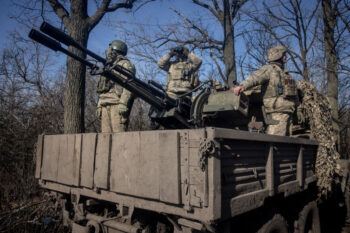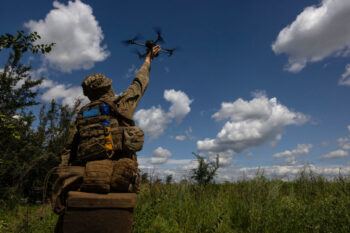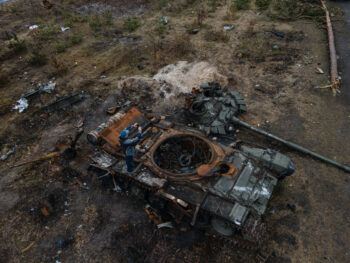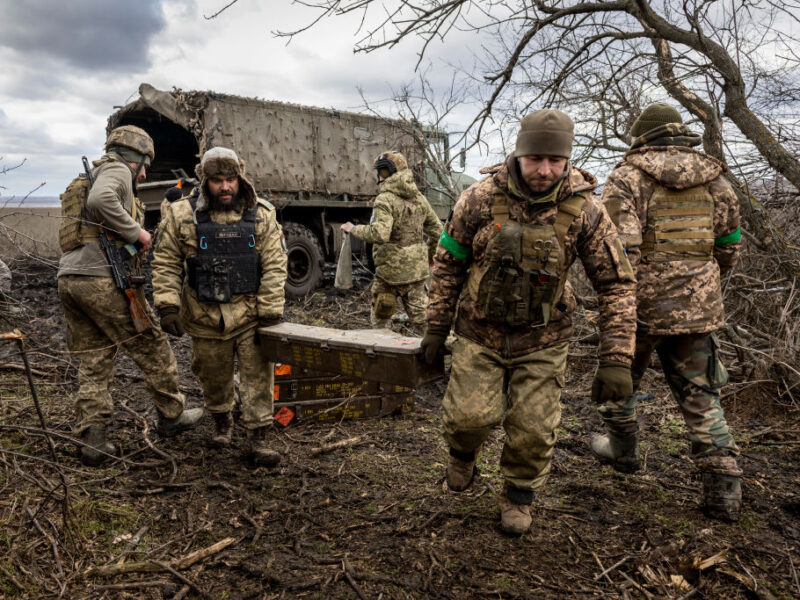What Can The Conflict In Ukraine Teach Us About The Future Of Warfare?

When Russian troops crossed the border into Ukraine on Feb. 24, 2022, few predicted that the invasion would be ongoing two years later.
As military historian and author Phillips Payson O’Brien remarked during a talk at Texas A&M University this week, “The war was supposed to be fast and overwhelming, and it was supposed to be done in a very short period of time.” Some experts predicted the war would be over in as little as a few weeks, said O’Brien, a professor of strategic studies at the University of St. Andrews in Scotland.
That mismatch between analysts’ expectations and the complex reality of the conflict, now in its third year, was the subject of O’Brien’s lecture hosted Monday by the Bush School of Government and Public Service’s Scowcroft Institute of International Affairs and Albritton Center for Grand Strategy, in collaboration with the Texas A&M Department of History.
When it comes to the Russian-Ukrainian conflict, O’Brien said, the sluggish pace of ground troops on both sides hasn’t been the only surprise: “The reality … has been different on almost every level,” he said, raising a number of important questions about the changing face of 21st century warfare.
Understanding these questions — which encompass topics from artificial intelligence to economics — will be crucial for the U.S. and other nations as they imagine what future wars might look like, O’Brien said.
“Anyone who says they have the answers now is full of it, but we hopefully have some idea of what questions we have to ask ourselves,” he said.
Drones And Artificial Intelligence
One defining characteristic of the war in Ukraine has been the prevalence of unmanned aerial vehicles or UAVs, O’Brien said. Also known as drones, thousands of these small, lightweight UAVs are being deployed by both sides, providing some key advantages over traditional fixed-wing aircraft that are expensive to produce and vulnerable to battlefield anti-aircraft weapons.
“The greatest change in production has been the shift away from fixed-wing (aircraft) production to the building of UAVs,” O’Brien said. “Both sides are flooding production of UAVs simply because they’re trying to overwhelm anti-aircraft systems with mass. If you throw up thousands of UAVs, they don’t cost that much and it’s almost more expensive to shoot them down.”

Current models of UAV are still vulnerable to electronic attacks, which can interfere with their positioning systems, O’Brien said. This has led both Russia and Ukraine to explore the potential of drones piloted by on-board artificial intelligence.
“If you can cut the GPS system, that UAV becomes nonfunctional,” O’Brien said. “But if you can throw it up and it doesn’t need that contact with the GPS and it can just function on its own, then that will make a massive difference. … But they’re not there yet.
“I do believe this is coming,” he said. “I think in five to 10 years, UAVs are going to be AI-driven.”
Production And Logistics
An often-overlooked aspect of this war and many others, O’Brien said, is the production and deployment of equipment, from vehicles to ammunition. Russia and Ukraine have both struggled in this area, as foreign aid to Ukraine dries up and Russia quickly runs through its stockpiles while failing to ramp up production.
“We are in a huge logistic competition because equipment is getting eaten up at the kind of rates no one imagined,” O’Brien said, noting that Russia fired 11 million artillery shells in the first year of the war and around seven million in the second year, with an estimated four million left in storage. “We have witnessed an extraordinary consumption of ammunition with very little production to back it up.”
Both sides will need to find an answer to this problem as soon as possible if they hope to stay in the fight. “I think logistics will determine this war,” O’Brien said.

In addition, O’Brien said American and Chinese officials should be paying special attention to this element of the conflict, as a war between the two major powers would largely hinge on each’s ability to sustain production and move equipment from factories to the battlefield.
“If the U.S. got into a war with China, it would probably be the consumption and destruction competition we’re seeing right now,” he said. “A U.S.-Chinese war would, I think, be very similar to Russia and Ukraine (in this way).”
Information Warfare
O’Brien said the most effective weapon in the Russian arsenal by far has been its ability to influence politics and public opinion in the United States. He pointed to House Republicans’ refusal to allow a vote on a new aid package for Ukraine approved by the Senate and strongly supported by President Joe Biden.
“It seems to me there is part of the Republican Party that has basically bought the Russian line and will not allow a vote because a vote would get through,” O’Brien said, noting that former president Donald Trump has expressed hesitance about defending certain NATO members in the event of further Russian aggression.
Thanks in large part to these political trends, O’Brien said, the war on the ground has shifted “from one where Ukraine had the ascendancy to one where Russia now has the ascendancy,” changing the course of the overall conflict and sowing doubt among America’s Eastern European allies, for whom this is an “existential war.”
“You could argue the millions the Russians have spent on information warfare have been far more effective to them than the billions they spent on the military,” he said. “The fact that the U.S. House of Representatives has not had a vote on aid to Ukraine is the most successful military operation of this war.”
Media contact: tamunews@tamu.edu





